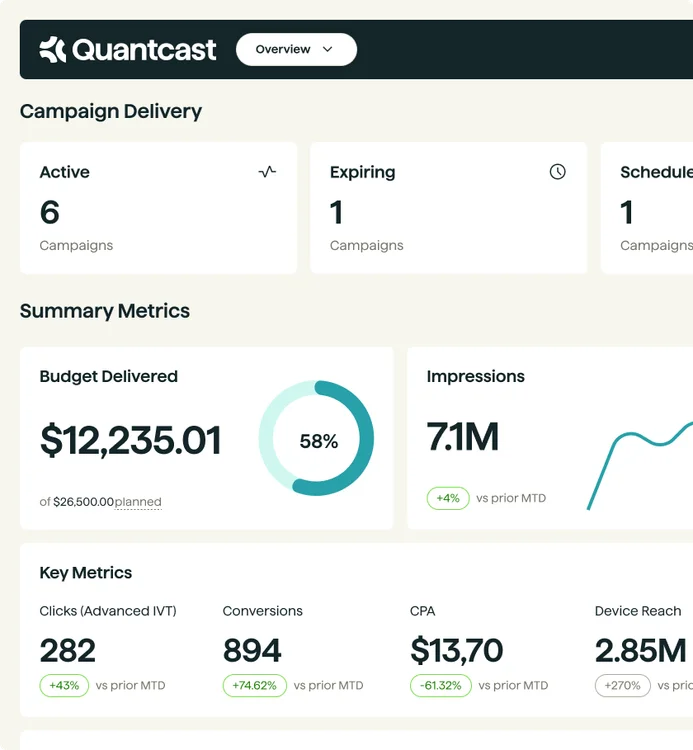Choosing Your Digital Advertising Partner: Not All Programmatic DSPs Are the Same

Written By
Team Quantcast

Not all programmatic DSPs are created equal, so learn how to evaluate key differences in data, AI, targeting, channels, and transparency to choose the best demand-side platform for your digital advertising goals.
In the dynamic world of programmatic advertising, the term "DSP" – Demand-Side Platform – is ubiquitous. It's the central nervous system for advertisers, enabling automated buying and selling of digital ad impressions. But just as not all cars are the same, under the hood, neither are all programmatic DSPs. Understanding these critical differences is paramount for any brand or agency seeking to maximize their return on ad spend and truly harness the power of programmatic.
At Quantcast, we often speak with marketers who assume a DSP is just a DSP. However, the reality is far more nuanced. While all programmatic ad platforms share the fundamental goal of connecting advertisers with publishers, their unique strengths, technological differentiators, and strategic approaches can dramatically impact campaign performance.
So, if you’re navigating the landscape of programmatic advertising platforms and striving to find the best programmatic advertising platforms for your needs, let’s delve into what sets them apart.
The Foundation: Core DSP Functionality
Before dissecting the differences, let's acknowledge the common ground. All reputable demand side platform programmatic advertising solutions offer:
- Real-Time Bidding (RTB): The ability to bid on individual ad impressions in milliseconds, optimizing spend based on precise targeting criteria.
- Access to Inventory: Connection to various ad exchanges and SSPs (Supply-Side Platforms) to access a vast pool of ad impressions across websites, apps, and other digital channels.
- Audience Targeting: Features to define and reach specific audience segments based on demographics, interests, behaviors, location, device, and more.
- Campaign Management: Tools for setting up, launching, pausing, and editing ad campaigns.
- Reporting & Analytics: Dashboards and reports to track key metrics like impressions, clicks, conversions, and spend.
These are the table stakes. Where DSPs truly differentiate themselves lies in the sophistication and depth of these core functionalities, along with specialized features and strategic focuses.
Key Differentiators: What Makes One DSP Stand Out?
When evaluating the top programmatic advertising platforms and the numerous programmatic advertising companies in the market, consider these crucial differentiators:
1. Data and AI Capabilities
This is arguably the most significant differentiator. While all DSPs use data, the quality, quantity, and processing power of that data, driven by artificial intelligence (AI) and machine learning (ML), can vary:
- Proprietary Data: Some DSPs have access to unique first-party data sets, publisher partnerships that can offer unparalleled insights for targeting, while others may be using third-party data. Quantcast has its own first-party data.
- AI-Driven Optimization: The sophistication of a DSP's AI algorithms for bid optimization, budget allocation, and predictive analytics can dramatically impact campaign efficiency and return on ad spend (ROI). Advanced AI can identify nuanced patterns, predict user behavior, and optimize bids in ways manual adjustments simply cannot.
- Identity Resolution: In a cookieless world, how a DSP approaches identity resolution (e.g., leveraging probabilistic vs. deterministic IDs or implementing privacy-preserving technologies) is critical for maintaining accurate audience targeting and measurement. Quantcast, for instance, focuses on cookieless solutions that prioritize user privacy while delivering performance.
2. Channel and Format Specialization
While many DSPs offer omnichannel capabilities, some excel in specific areas:
- Programmatic Video Advertising: A DSP might have superior integrations with connected TV (CTV) and over-the-top (OTT) publishers, offering advanced video-specific targeting, measurement, and creative capabilities.
- Programmatic Audio Advertising: For brands leveraging podcasts, streaming music, or digital radio, a DSP with robust programmatic audio advertising features, including dynamic audio creative and deep partnerships with audio publishers, is essential.
- Programmatic Native Advertising Platform: Some DSPs specialize in creating and distributing native ads that seamlessly blend with surrounding content, offering a less intrusive and often more engaging user experience.
- Programmatic Display Advertising Platform: While foundational, the quality of display inventory access, creative flexibility, and anti-fraud measures can still vary.
3. Self-Serve vs. Managed Services
This directly impacts your level of control and the resources required:
- Self-Serve Programmatic Advertising: For marketers who want direct control over their campaigns, a self serve programmatic advertising platform is ideal. These self-serve programmatic platforms empower users to set up, manage, and optimize campaigns independently. They require in-house expertise but offer transparency and flexibility. Quantcast provides powerful self-serve capabilities designed for efficiency and ease of use.
- Managed Services: Some top programmatic companies offer fully managed services, where their team handles campaign setup, optimization, and reporting. This is suitable for businesses with limited in-house programmatic expertise or those preferring a hands-off approach. It often comes with higher minimum spends but can provide access to advanced strategies and dedicated support.
4. Integrations and Ecosystem
A DSP doesn't operate in a vacuum. Its ability to integrate with other platforms is crucial:
- Data Management Platforms (DMPs): Seamless integration with DMPs allows for more sophisticated audience segmentation and activation.
- Customer Relationship Management (CRM) Systems: Connecting with CRM data can unlock powerful first-party data activation for retargeting and customer loyalty campaigns.
- Measurement and Attribution Tools: The ability to integrate with third-party analytics and attribution platforms ensures accurate performance measurement across the entire customer journey.
- Creative Management Tools: Some DSPs offer integrated creative studios or seamless connections to ad servers for dynamic creative optimization (DCO).
5. Transparency and Brand Safety
In an era of increasing scrutiny, a DSP's commitment to transparency and brand safety is non-negotiable:
- Inventory Quality: Does the DSP provide clear insights into the quality of inventory it accesses, including viewability rates and invalid traffic (IVT) prevention?
- Reporting Granularity: Can you see exactly where your ads are running, down to the domain or app level? This level of detail is crucial for optimizing placements and ensuring brand suitability.
- Brand Safety Controls: Robust pre-bid and post-bid brand safety tools, often integrated with third-party verification providers, help protect your brand from appearing next to unsuitable content.
6. Pricing Models and Minimums
The cost structure of DSPs can vary:
- Percentage of Media Spend: Many DSPs charge a percentage of the total media spend.
- Fixed Fees/Subscription: Some may have a flat monthly or annual fee, sometimes combined with a media spend percentage.
- Minimum Spend Requirements: While some self-serve programmatic platforms offer low or no minimums, many larger DSPs, including some among the top programmatic companies, require significant monthly ad spend, which can be a barrier for smaller businesses.
The "Best Performing" DSP: It's About Your Needs
There isn't a single "best programmatic platform" for everyone. The ideal choice depends entirely on your specific marketing objectives, budget, in-house capabilities, and target audience.
When evaluating the programmatic advertising platforms list, ask yourself:
- What are my primary advertising goals (e.g., brand awareness, lead generation, e-commerce sales)?
- Which channels are most critical for reaching my audience (e.g., video, audio, display, native, CTV)?
- What level of control and transparency do I require?
- What is my monthly or annual ad spend budget?
- How much in-house expertise do I have for managing programmatic campaigns?
For brands seeking an intelligent, privacy-centric approach to programmatic advertising, Quantcast offers a cutting-edge programmatic advertising demand side platform that leverages AI and real-time audience intelligence to deliver performance. Our focus on transparent, actionable insights, and powerful self-serve capabilities empowers marketers to take control of their digital advertising destiny.
In a world where every ad dollar counts, understanding that not all programmatic DSPs are the same is the first step towards smarter, more effective digital campaigns. Choose wisely, and empower your brand with the programmatic powerhouse that aligns perfectly with your vision for growth.
Ready to explore how programmatic can transform your advertising strategy? Contact Quantcast today to learn more about our high performance programmatic advertising demand side platform and how we can help you achieve your marketing goals.
Share article
Ready to get started with programmatic advertising?

